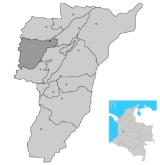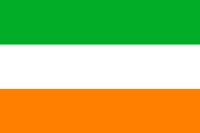
Montenegro, Quindío
Encyclopedia

Quindío Department
Quindío is a department of Colombia. It is in the western central region of the country, crossed by the Andes mountains. Its capital is Armenia. It is famous for the quality of the coffee plantations, colorful architecture, benign weather, variety of hotel accommodations and touristic landmarks...
, Colombia
Colombia
Colombia, officially the Republic of Colombia , is a unitary constitutional republic comprising thirty-two departments. The country is located in northwestern South America, bordered to the east by Venezuela and Brazil; to the south by Ecuador and Peru; to the north by the Caribbean Sea; to the...
. It is located 10 km west of the departmental capital Armenia
Armenia, Colombia
Armenia is the capital of Quindío, a department in Colombia. The city is located at coordinates 4.5170° north, 75.6830° west, 290 kilometers west of Bogotá. Armenia is a mid-size city located between Bogotá, Medellín and Cali, the 3 largest Colombian cities. The city's area code for phone calls is...
.
Montenegro (literally: Black Mountain) was named for the dark green color of the trees that originally covered the hill above the current-day site of the township, which was visible from other parts of the region as it rose above the surrounding guadua forests. Between 1897 and 1904, Montenegro was officially known as Villa Quindío.
The boundaries of Montenegro are principally formed by three rivers. To the north, the Roble River forms the limit with Quimbaya
Quimbaya, Quindío
Quimbaya is a town and municipality in the western part of the department of Quindío, Colombia. It is 20 km northwest of the departmental capital Armenia...
; to the east and south, the Espejo River forms the limit with Armenia and La Tebaida
La Tebaida, Quindío
La Tebaida is a municipality in the western part of the department of Quindío, Colombia. It is located 17 km southwest of the departmental capital Armenia.In 2005 it had an estimated population of 30,300, of which 27,000 live in the main urban zone....
; and to the west La Vieja River
La Vieja River
La Vieja River is a river in the Colombiandepartments of Quindío, Valle del Cauca and Risaralda.It is a major tributary of the Cauca River.The river is formed by the joining of the Quindío River and the...
is the limit with the neighboring department of Valle del Cauca. There is also a short boundary with Circasia
Circasia, Quindío
Circasia is a municipality in the northern part of the department of Quindío, Colombia. It is located 7 km north of the department's capital Armenia....
in the northeast of the municipality.
In 2005 it had an estimated population of 45,000, of which 36,400 live in the main urban zone.
Located in the heart of Colombia's coffee zone, Montenegro is also home to the National Coffee Park
Colombian National Coffee Park
The Colombian National Coffee Park is a theme park located in the department of Quindío, Colombia, 4 km south-west of the town of Montenegro and 11 km west of the departmental capital city Armenia...
. Founded by the Colombian Coffee Federation
Federación Nacional de Cafeteros de Colombia
The Federación Nacional de Cafeteros de Colombia , often abbreviated Fedecafé, is a non-profit business association, popularly known for its "Juan Valdez" marketing campaign. The federation was founded in 1927 as a business cooperative that promotes the production and exportation of Colombian coffee...
, the park hosts numerous thematic attractions based on Colombian history and the country's thriving coffee culture. The rural landscape of Montenegro is typical of the coffee zone, and the hotel and posadas infrastructure has increased dramatically in the 2000-2005 period. It is an important tourism and convention destination for a relaxed vacation featuring nature-watching and cultural trips (related to the coffee-growing techniques).
History
The first people to arrive in Montenegro in the modern era were treasure hunters (Spanish: guaqueros), attracted by reports of gold artefacts in indigenous burial sites in the area. In the 1880s more than 1,500 people arrived from as far away as AntioquiaAntioquia Department
Antioquia is one of the 32 departments of Colombia, located in the central northwestern part of Colombia with a narrow section that borders the Caribbean Sea. Most of its territory is mountainous with some valleys, much of which is part of the Andes mountain range...
in search of treasure. One of the earliest settlers was María Antonia "Toñíta" Granada, a widow originally from Pácora
Pácora, Caldas
Pácora is a town and municipality in the Colombian Department of Caldas....
, Caldas
Caldas Department
Caldas is a department of Colombia named after Colombian patriotic figure Francisco José de Caldas. It's part of the Paisa Region and its capital is Manizales. The population of Caldas is 1,030,062, and its area is 7,291 km²...
. In 1884 she built a house in what is now the center of the township, close to the River Roble. She became the first woman registered as a founder of a town in Quindío.
Miguel Duque Betancourt bought the land for the township for a price of 300 pesos, from Agapito Herrera, the municipal judge in Salento
Salento, Quindío
Salento is a town and municipality in the north-east of the department of Quindío, Colombia. The municipality covers an area of 377.67 km2. It was the first settlement in Quindío of the modern era, and the first municipality founded in the department. The town of Salento itself is located 24 km...
. Along with his parents, Duque had arrived in the area from Salamina
Salamina, Caldas
Salamina is a town and municipality in the colombian department of Caldas. It is located north of the department and has a township called San Felix. It was declared a national monument and historic heritage of mankind....
, Caldas. They settled in what would later become the vereda La Esmeralda.
Although he was only 25 years old, Duque became the president of the municipal council, which met for the first time on October 17, 1890. This date is now considered the foundation date for Montenegro. Seven years later, on September 10, 1897, Montenegro was recognized as a town (corregimiento) of the municipality of Filandia
Filandia, Quindío
Filandia is a town and municipality in the northern part of the department of Quindío, Colombia. It is located on the west side of Cordillera Central of the Andes mountain range running through central Colombia, 26 km north of the departmental capital Armenia. It is the northernmost of twelve...
. It became a separate municipality on April 6, 1911.

